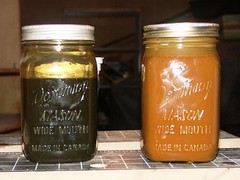Water Washing
There is a theory that states that if you add water to vegetable oil you can remove particulates (suspended gunk) and make it cleaner.
Or so is the theory. I figured I'd try it with my new batch of oil. Originally both jars ofoil had as much oil as in the 1st jar and both looked the same. Both jars of oil were unfiltered (I'll try the results of filtering them first later). I added water to the 2nd jar and shook it up. This should cause the water to become attached to the bits and drag them down to the bottom. This should make the oil cleaner. Right now it looks like moldy tomato soup.
In reality you have two methods of "washing" the oil properly. The first is to add a set amount of water and then insert a bubbler and air stone in the bottom. This carries the water to the top coating the bubbles and in effect grabs all of the bits and when the bubble pop the water drops down to the bottom. This takes less water, but a longer time to work. It's called Bubble washing.
The second method is mist washing. That process takes a very fine misting sprinkler head (those little tiny ones) and sprays the water down onto the oil. It then carries the bits down with the water to the bottom and out of suspension in the oil. This takes a lot shorter time, but it takes more water.
Either method you have to syphon off the water from the bottom (or have a valve to open and pour out of) when you're done. Then you heat it as before mentioned and get any leftover water out of the oil.
Washing is a longer process. Some don't do the washing bit and just filter, heat and settle. What I do depends on how my tests conclude. I figure I'll try one mroe test with washing filtered oil and present the results.


0 Comments:
Post a Comment
<< Home